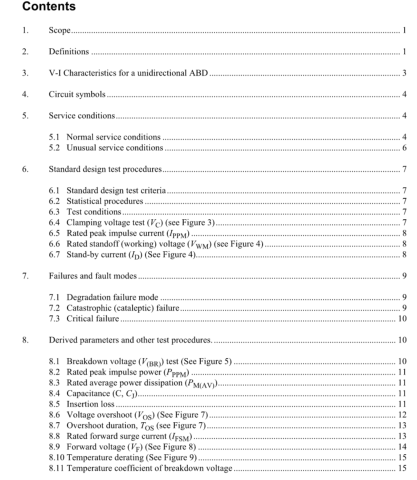IEEE C62.3-2010 pdf download.IEEE Standard Test Methods for Avalanche Junction Semiconductor Surge-Protective Device Components
5. Service conditions
5.1 Normal service conditions
The following items should be the conditions unless otherwise specified by the manufacturer.
5.1.1 Environmental conditions
5.1.1.1 Operating temperature ranges
a) Normal operating range:- 5 °Cto +55 °C
b) Extended operating range: -40 °C to +85。C
5.1.1.2 Maximum humidity
Relative humidity under the operating conditions shall be less than 96 % at 25 °C.
5.1.1.2 Maximum humidity
Rclative humidity under the operating conditions shall be less than 96 % at 25 °C. NOTE- For test methods see IEC 60068-1 (1988- 06) Ed. 6.0 [B2], IEC 60068-2-30 (1980-01) Ed. 2.0 [B9], IEC 60068-2-38 (1974-01) Ed. 1.0 [B10], IEC 60068-2-78 (2001-08) Ed. 1.0 [B16], IEC 60749-5 (2003-01) Ed. 1.0 [B21] and IEC 60749-33 (2004-03) Ed.1.0 [B22].
5.1.1.3 Mechanical shock and vibration The purpose of this test is to determine mechanical weakness, degradation or both in specified performance and to use the information, in conjunction with the relevant specification, to decide whether a component is acceptable or not. NOTE- -For test methods see IEC 60068-2-6 (1995-03) Ed. 6.0 [B3].
5.1.2 Physical properties The purpose of this clause is to determine physical properties of the component in specified performance with the relevant specification, and to allow the reader to use the information to decide whether a component is acceptable or not.
5.1.2.1 Solvent resistance
The resistance of the ABD component against speified chemical solvent shall be detemined. The manufacturer shall provide the data if it is required.
5.1.2.2 Solderability The slderability of the area on lead wire or surface mount terminals that are required to be wetted by solder shall be determined. if required, any de-wetting characteristics shall be determined and specified. NOTE- for test methods see IEC 60682-20 (1979-01) Ed.4.0 (B6].
5.1.2.3 Flammability The fammabilit of ABD components shall be dermined and specified.
NOTE- For lest methods see 1EC 6069-2-2 (1991-05) Ed.20 [B181. IEC 60695-2-13 (000-10) Ed.1.0 [B19].1EC/ TS 60695-2-20 (00-02) Ed. 20 (B20] and UL 94 Ed 5 (1996) [B29]. 5.1.3 System conditions The pupose of this clause is to determine system condlitions where ABD components that conform to this standard may be applied.
5.1.3.1 Nominal system frequencies ABD components may be applied in systems where the frequency is between zero (DC) and several GHz. Use on a particular system would be dependant on the individual ABD component’s capaciance and leakage current, and the system’s ability to cope with the load presented by the ABD component.
5.1.3.2 Maximum continuous system voltage It is recommended that the Kwm of the ABD components applied in a system should be greater than the maximum voltage encountered in the system’s normal openation over the operating temperature range.
5.3.3 Surge environment It is recommended that the ABD component surge ratings should eceed the expected ampltude, wave shape and frequency of ocurrence of surges in the system application over the expected system ambient temperature range. If the ABD component is subjeet to other than normal application or service conditions, they may require special consideration in design, manufacture or applicationo
5.1.3.4 Temperature environment It is recommended that the ABD component electical ratings and characteristics. ater temperature derating for the expected ambient temperature range of the system, meet the system needs.
5.1.3.5 Maximum pulse currnt The maximum pulse current of specifed wave shape that normally occurs. It is recommended that ABD components applied to the system should have Ipp ratings that meet or exceed this system conditon over the expected system ambient temperalure range.
5.1.3.6 Transient power repetition rate The maximum transient repetition rate of specifed wavefom that nomally occurs in the system. It is recommended that the ABD conmponents applied to the system should have a duty eyele ratig or capability that exceeds the system’ s maximum transient retitio fate.
5.2 Unusual service conditions The fllowing service conditions may require special consideration in the design or application of ABD suppressors and should be called to the attention of the manufacturer. NOTE- -The use of this standard in case of unusual service condirins is subjct t0o agrerment betwen the manuficturer and the purchaser.IEEE C62.3 pdf download.IEEE C62.3-2010 pdf download
IEEE C62.3-2010 pdf download

Leave a Reply